VIA's Dual Core Nano & VN1000 Chipset Previewed
by Anand Lal Shimpi on November 15, 2010 12:26 PM ESTCPU Performance
Overall CPU performance is typically leaps and bounds better than Intel’s dual-core Atom D510. However that’s an easy target to beat. If we look at an identically (or even lower) clocked Pentium or Celeron dual-core processor, VIA loses.
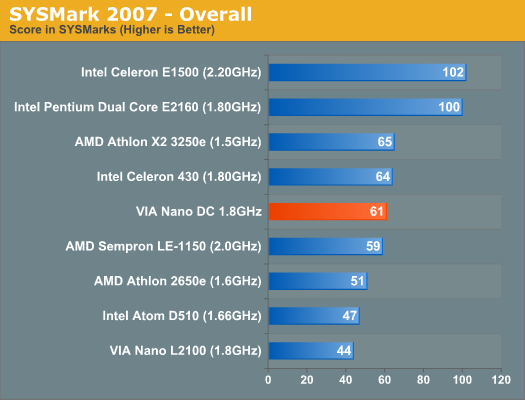
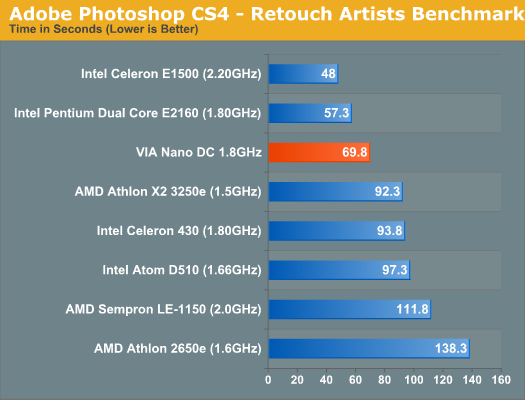
Photoshop performance is actually pretty impressive for the platform we're looking at. You get performance that's in the range of low end Pentium Dual-Core processors.
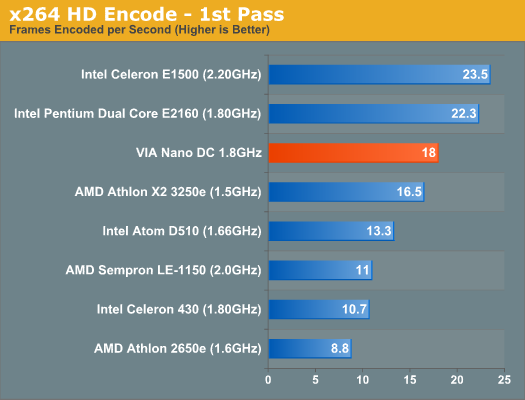
Even video encoding impresses as the DC Nano platform is faster than AMD's dual-core 1.5GHz Athlon X2. Intel has the performance-per-clock advantage with the Pentium dual-core but Atom is nowhere near it.
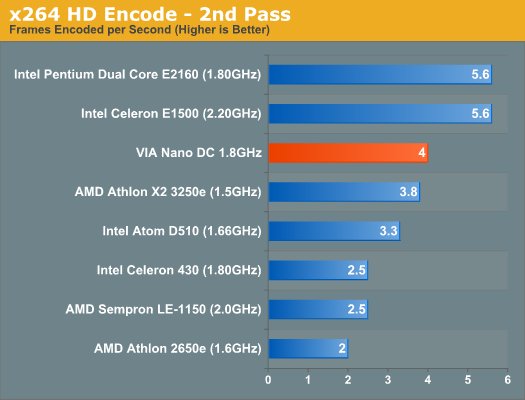
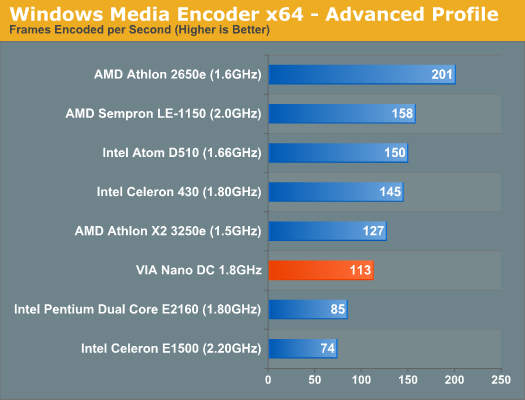
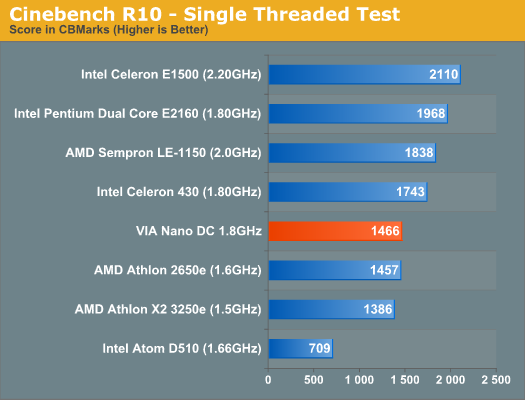
Nano's single threaded performance is really where it shines vs. Atom. You get roughly double the performance, which is quite visible in normal OS interaction or light apps like web browsing. Everything just pops up a lot quicker.
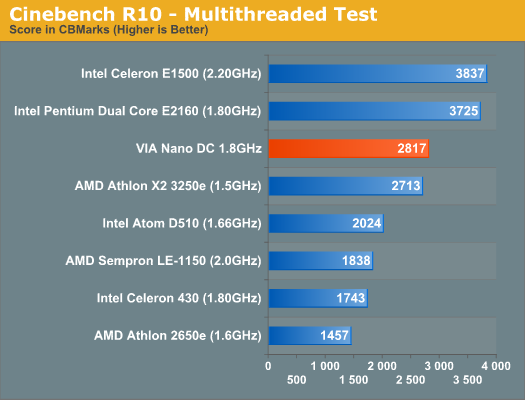
With a second core at its disposal the new Nano does very well in multithreaded environments as well. Again we have it besting the Athlon X2 3250e.
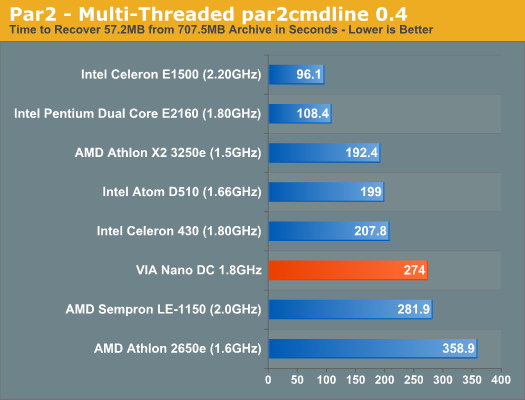
I ran our Par2 test here because it is highly optimized for Intel architectures. It is a real world test however and it shows you that despite VIA's architectural advantages, there will be situations where even an Atom may be faster.
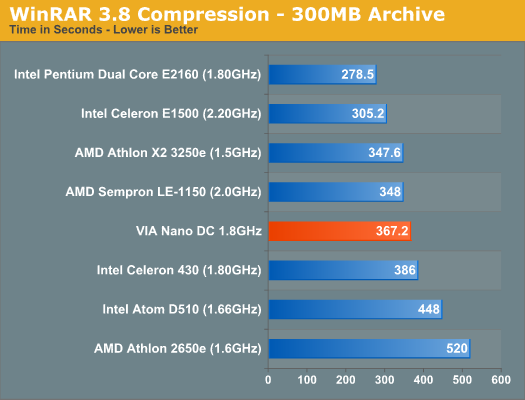
In most cases however, the DC Nano will be noticeably faster than a Pineview Atom and within striking distance of an Athlon X2.










54 Comments
View All Comments
tipoo - Monday, November 15, 2010 - link
So what I take from this is that performance usually beats Atom+Intel IGP, but that 65nm fabrication process means they aren't competitive in power draw.IntelUser2000 - Monday, November 15, 2010 - link
Sorry, AMD on the same 40nm TSMC will have similar performance for CPU, and have far less TDP.No, Via's designs are just years and years behind. They probably need 22nm RIGHT NOW to be competitive.
tipoo - Monday, November 15, 2010 - link
Huh? This is 65nm, and like you yourself said AMD's is on 40nm. Its not the same like you said. But you are right in saying that it also needs architectural improvements.DanNeely - Monday, November 15, 2010 - link
40nm will help a lot on load power, but until they implement power gating (and this is somewhere Intel still leads AMD significantly) idle power is going to remain a major liability.chucky2 - Monday, November 15, 2010 - link
Forget the speed of this thing for a moment, and the power consumption:What about stability and compatibility?
If VIA is going to try and make a come back - of any type - then reviewers need to do much more stability and compatibilty testing than with products based on Intel or AMD solutions, as those were the major issues with VIA in the past. It wasn't that they had bad speed or high power consumption of the money you paid for them, it's that they had an unacceptable level of stability and compatibility issues.
For anyone familiar with the VIA of old, that will be the benchmark they're weighed against before speed or power consumption even come into question. Doesn't matter how fast something is, or how little power it consumes, if there's a good chance it's going to crash on me with regular usage, or, if the common component I'll be plugging into it is going to have issues (because of VIA) or crash (because of VIA).
Sure hope VIA learned from its past history.......
Chuck
strikeback03 - Monday, November 15, 2010 - link
Well this is labeled as a preview, maybe more of that will come when they have final shipping hardware.ProDigit - Monday, November 15, 2010 - link
Please, when you review bobcat, compare it to this nano chip!The results might prove interesting.
I believe the Nano could have better CPU, while worse GPU ratings than the AMD one.
Power consumption of the Nano @40nm should be between 28W and 40W idle/load; unless they are able to optimize the nano, and integrate some overclocking (like intel's turbo boost technology).
It'd be nice to see some downclocking or core disablement on this cpu too!
Via has much to invest in if it wants to be competitive with Intel!
nitrousoxide - Monday, November 15, 2010 - link
It will not out-perform Fusion APU, which has approximately 80% the performance of current low-voltage Athlon II X2 CPUs, that is really impressive power.Zingam - Monday, November 15, 2010 - link
nvidia should buy themShloader - Monday, November 15, 2010 - link
Actually... Yeah! If not that then at the very least create a strong partnership with them. Were that to happen a lot of the Linux compatibility questions go right out the window (unfortunately letting in a lot of power consumption questions). nVidia needs to team up with a player in the x86 CPU market and insure a platform for their discreet graphics + chipset business. Remember it was nVidia that led the way to dual channel memory on the x86 platform. Get that DDR3 memory controller integrated along with an integrated nVidia GPU on a 22 to 32 nm process. I would actually buy something for HTPC if both those companies shared the helm. nVidia's additions would make a lot of the core performance questions irrelevant for me. Just give me enough cuda power to play my vids while speeding up h.264 encoding.